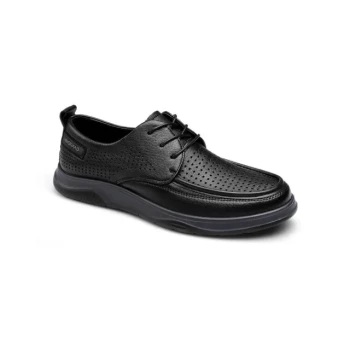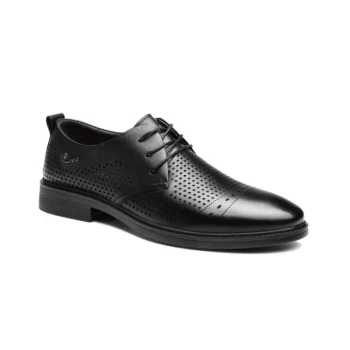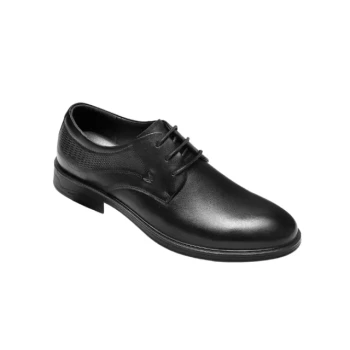The choice of materials is the single most critical factor in determining an office shoe's comfort and appearance. High-quality materials like premium leather provide a superior experience by molding to your foot for personalized comfort while simultaneously presenting a polished, professional look. Conversely, synthetic materials offer benefits like lighter weight and increased flexibility, often at the expense of formal appearance and long-term durability.
The core decision is not simply leather versus synthetic, but a strategic trade-off between properties like breathability, durability, and weight. The ideal material is the one that best aligns with your specific work environment, daily activity level, and professional aesthetic.
The Foundation of Comfort: How Materials Shape the Feel
Comfort in a work shoe is not a single feature but an engineered system. The materials used in every part of the shoe—from the upper that wraps your foot to the insole that cushions it—work together to define your all-day experience.
The Role of the Upper Material
The "upper" is the main body of the shoe that covers your foot, and its material is crucial for fit and breathability.
Premium leather is prized for its ability to conform to the unique shape of your foot over time, creating a custom, glove-like fit. This adaptability minimizes pressure points and friction.
Synthetic materials, including breathable textiles and flexible Nubuck leather, are significantly lighter. This reduces fatigue during long days and makes them an excellent choice for warmer weather or more active roles.
The Internal Architecture: Cushioning and Support
What's inside the shoe is just as important as what's on the outside.
A cushioned footbed made from innovative foams provides immediate, lasting comfort underfoot. These materials are designed to absorb shock with every step.
A supportive insole and heel prevent arch pain and promote proper alignment. The structure and density of these materials are engineered to provide stability throughout the day.
The Language of Appearance: What Materials Signal
A shoe's material communicates a message before you ever say a word. It's a key element of your professional presentation.
Leather: The Gold Standard of Professionalism
Full-grain and premium leathers are the undisputed standard for a formal, professional look. Their natural texture and ability to take a polish signal quality and attention to detail.
Well-maintained leather also develops a unique patina over time, enhancing its character and appearance, which is something synthetic materials cannot replicate.
Synthetics and Textiles: Modern and Casual Aesthetics
Shoes made from textiles or other synthetic materials tend to project a more modern or business-casual image.
They offer a wider range of colors and textures but generally lack the gravitas required for highly formal business environments.
Understanding the Trade-offs
Choosing the right material is a balancing act. There is no single "best" option, only the best option for a specific need.
Durability vs. Weight
Leather is exceptionally durable and protective, but it is also heavier. The materials used in the sole and welt add to this weight but are essential for the shoe's longevity.
Synthetic materials are lighter and more flexible, but may not offer the same level of long-term durability or protection against the elements.
Breathability vs. Protection
Breathable textiles are ideal for summer months or indoor environments, as they allow heat and moisture to escape, keeping your feet comfortable.
Less breathable materials like waterproofed leather or those with built-in membranes offer superior protection from rain and cold, making them essential for commuting in poor weather.
Making the Right Choice for Your Environment
Your daily reality should guide your decision. Match the material's properties to your primary needs.
- If your primary focus is a formal, corporate setting: Choose premium leather for its polished appearance and ability to mold to your foot for long-term comfort.
- If your primary focus is all-day activity in a business-casual office: Opt for shoes with breathable textile or flexible Nubuck leather uppers to prioritize low weight and flexibility.
- If your primary focus is commuting in variable weather: Select a waterproofed leather or a shoe with a protective membrane to ensure your feet stay dry without sacrificing a professional look.
By understanding the properties of these materials, you move from simply buying a shoe to investing in the right tool for your professional life.
Summary Table:
| Material Type | Key Comfort Feature | Key Appearance Feature | Ideal For |
|---|---|---|---|
| Premium Leather | Molds to foot for personalized fit | Polished, formal, professional | Formal corporate settings |
| Synthetics / Textiles | Lightweight, flexible, breathable | Modern, business-casual | Active, business-casual offices |
| Waterproofed Materials | Protection from elements | Maintains professional look | Commuting in variable weather |
Ready to invest in the perfect office shoes for your team?
As a large-scale manufacturer, 3515 produces a comprehensive range of footwear for distributors, brand owners, and bulk clients. Our expertise ensures you get the ideal balance of material quality, comfort, and professional appearance tailored to your specific market needs.
Contact us today to discuss your requirements and discover how we can support your business with high-quality, comfortable footwear solutions.
Related Products
- Custom Manufactured Air Cushion Leather Business Shoes for Wholesale
- Wholesale Comfortable Business Casual Shoes Custom Manufacturing
- Wholesale Modern Business Shoes with Dial Closure System for Bulk Orders
- Wholesale Leather Derby Shoes Manufacturer | Customizable Business & Dress Footwear
- Factory Direct Wholesale Leather Comfort Shoes with Dial Closure
People Also Ask
- What are the characteristics of business casual sneakers? Master the Polished & Professional Look
- Are sneakers acceptable in a business casual workplace? How to Choose the Right Style
- How does leather compare to other shoe materials in terms of durability and comfort? A Material Guide for Footwear
- Can trainers/sneakers be worn in a business casual setting? How to Choose the Right Style for a Professional Look
- Are sneakers appropriate for business casual settings? A Guide to Modern Office Footwear



















